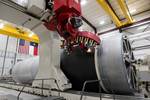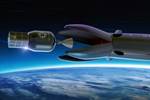Rocket Lab begins installation of large AFP machine for rocket production
The 99-ton AFP machine, custom-designed and built by Electroimpact, is claimed to be the largest of its kind, expecting to save around 150,000 manufacturing hours in the Neutron rocket’s production process.
Rocket Lab USA Inc. (Long Beach, Calif., U.S.), a global launch services and space systems company, has begun installation of what it claims is the largest automated fiber placement (AFP) machine of its kind into the company’s Neutron rocket production line in Middle River, Maryland. The AFP machine will enable Rocket Lab to automate production of the largest carbon fiber composite rocket structures in history.
The custom-built 99-ton, 12-meter-tall robotic machine, made by Electroimpact (Mukilteo, Wash., U.S.), has just completed final acceptance testing with the manufacturer and installation has begun at Rocket Lab’s Space Structures Complex in Middle River. The new machine will automate the production of all large composite structures of the Neutron launch vehicle, including the panels that make up the 28-meter-length interstage and fairing, 7-meter-diameter first stage and the 5-meter-diameter second stage tank.
The autonomous machine can move up to 30 meters in length and lay down continuous carbon fiber at a rate of 100 meters per minute. The AFP machine also has a fully automated real-time inspection system that hunts for minuscule defects throughout the carbon fiber laminate and alerts the machine operator of any issues before the machine begins laying down the next layer, providing additional assurance that these critical structures meet Rocket Lab’s high-quality standards required for reusable Neutron launches.
As Neutron’s composite structures move into full-scale production, this autonomous machine is expected to introduce significant time savings of 150,000+ manufacturing hours into the production process.
“As we build the world’s largest carbon [fiber] composite rocket, it makes sense that we require a world-first carbon [fiber] composite fiber placement machine,” Rocket Lab founder and CEO, Sir Peter Beck, says. “We’re combining our proprietary flight-proven carbon [fiber] composite technology, additive manufacturing and autonomous robotics to design and build large-scale aerospace components at a pace that will support not only Neutron’s launch cadence, but support Electron and carbon [fiber] composites structures for our spacecraft customers, too. We worked closely with our partners at Electroimpact to create this robot.”
The AFP machine will also be leveraged to print smaller carbon fiber composite Neutron structures, first stages of Rocket Lab’s Electron launch vehicle and other flight-proven composite structures for space including spacecraft structural panels and assemblies, solar panel substrates, carbon composite tanks and primary structures, and custom projects for the aerospace industry.
Related Content
-
Paris Air Show 2023 highlights
The Paris Air Show, one of the largest aerospace trade shows in the world, returned for the first time since 2019 and proved that the global aviation industry industry is very much alive and kicking.
-
Daher CARAC TP project advances thermoplastic composites certification approach
New tests, analysis enable databases, models, design guidelines and methodologies, combining materials science with production processes to predict and optimize part performance at temperatures above Tg (≈150-180°C) for wing and engine structures.
-
Recycling end-of-life composite parts: New methods, markets
From infrastructure solutions to consumer products, Polish recycler Anmet and Netherlands-based researchers are developing new methods for repurposing wind turbine blades and other composite parts.
















